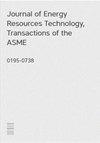Effects of Trapped Gas in Fracture-Pore Carbonate Reservoirs
IF 2.4
3区 工程技术
Q3 ENERGY & FUELS
Journal of Energy Resources Technology-transactions of The Asme
Pub Date : 2023-11-07
DOI:10.1115/1.4063931
引用次数: 0
Abstract
Abstract Fracture-pore carbonate reservoirs exhibit strong microscopic heterogeneity and complex seepage characteristics, resulting in suboptimal oil drive efficiency and development outcomes. Moreover, water channeling is often a serious problem in the development of fractured porous carbonate rocks, and the blockage of degassed bubbles in the throat is one of the reasons that cannot be ignored. In order to reveal the degree of influence of bubbles on waterflood sweep, this paper employs microfluidic technology to design three distinct chips, namely fracture-type, composite-type, and cave-type, to visually illustrate the influence of the gas phase on three-phase flow. A quantification method is established to analyze the variation characteristics of pore diameter utilization ratio in different types of carbonate reservoirs. Compared with water flooding experiments without the gas phase, the recovery factor of water flooding with the presence of the gas phase decreases by 0.6,3.4, and 15.3 percentage points for three distinct chips, respectively. In fracture-type reservoirs, the main focus is on sealing the primary fracture seepage channel and mitigating the shielding effect of the gas phase on matrix utilization. For composite-type reservoirs, the primary objective is to seal fractures and eliminate the shielding effect of the gas phase. In cave-type reservoirs, the primary goal is to eliminate the sealing effect caused by the discontinuous gas phase within small pore throats.缝孔型碳酸盐岩储层圈闭气的影响
缝孔型碳酸盐岩储层微观非均质性强,渗流特征复杂,导致其驱油效率和开发效果欠佳。此外,在裂缝性多孔碳酸盐岩发育过程中,水窜往往是一个严重的问题,喉道脱气气泡的堵塞是不可忽视的原因之一。为了揭示气泡对水驱波及的影响程度,本文采用微流体技术设计了裂缝型、复合型和洞型三种不同的切屑,直观地说明气相对三相流动的影响。建立了定量分析不同类型碳酸盐岩储层孔径利用率变化特征的方法。与不含气相的水驱实验相比,有气相存在的三种不同芯片的水驱采收率分别降低了0.6、3.4和15.3个百分点。在裂缝型储层中,主要重点是封堵裂缝主渗流通道,减轻气相对基质利用的屏蔽作用。对于复合型储层,主要目的是封堵裂缝,消除气相的遮挡作用。在溶洞型储层中,首要目标是消除小孔喉内气相不连续所造成的封闭作用。
本文章由计算机程序翻译,如有差异,请以英文原文为准。
求助全文
约1分钟内获得全文
求助全文
来源期刊
CiteScore
6.40
自引率
30.00%
发文量
213
审稿时长
4.5 months
期刊介绍:
Specific areas of importance including, but not limited to: Fundamentals of thermodynamics such as energy, entropy and exergy, laws of thermodynamics; Thermoeconomics; Alternative and renewable energy sources; Internal combustion engines; (Geo) thermal energy storage and conversion systems; Fundamental combustion of fuels; Energy resource recovery from biomass and solid wastes; Carbon capture; Land and offshore wells drilling; Production and reservoir engineering;, Economics of energy resource exploitation

 求助内容:
求助内容: 应助结果提醒方式:
应助结果提醒方式:


